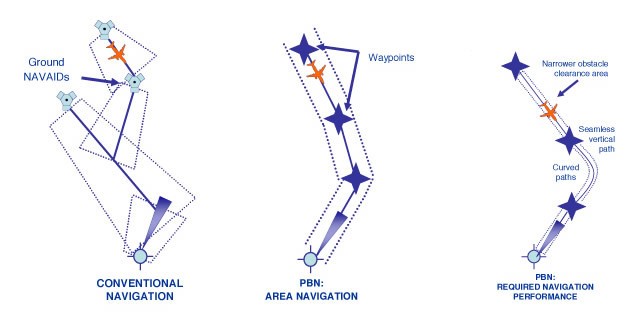As airspace becomes more congested and more noise sensitive, conventional navigation aids can begin to lose the safety and operational benefits they once offered. The advantages of implementing Performance Based Navigation instead are numerous, even for general aviation airfields and many smaller specialist operators. However, while the benefits may be clear, sometimes the business case is not.
More precise navigation
Unlike conventional navigation, Performance Based Navigation (PBN) requires an area navigation (RNAV) system that integrates raw navigation data to provide positioning and navigation.
The performance (i.e., accuracy, integrity, availability and continuity) is monitored on board, and this system of monitoring and alerting determines whether a navigation system complies with the required safety level. The result is navigation routes and approaches that are more precise, and safer. It also provides options for creating very specific routes at a minimum cost.
Some very specific benefits
So far, it has been mainly the larger airports that have been keen to implement PBN. France, for example, has been introducing RNAV approaches at 50 regional airports since 2016, all with the aim of eventually decommissioning the current ILS installation.
PBN could be just as interesting at smaller airfields. Where before, installing and maintaining a VOR or ILS approach would not be economically viable, a PBN approach could be since it allows a generally higher traffic capacity, as well as more operational capacity during bad weather conditions.
But beyond these general benefits, there are some very specific ways in which PBN can offer a distinct advantage over traditional navigation systems. PBN can assist helicopters in flying highly accurate routes in heavily congested areas so that the noise nuisance can be kept to a minimum, for instance. It can give HEMS operators more options for flying back to their home station in bad weather, often a hospital where installing an ILS would be impossible. It gives private owners and operators of helicopters more flexibility in flying to and from remote locations they visit frequently.
One situation in which PBN offers a distinct advantage is in obstacle-rich environments. The ability to fly very specific routes allows for low-level flight around obstacles, such as when inadvertently picking up ice. Low-level military flying exercises are another example of where the benefits of PBN performance and accuracy is clear.
Making the case
To make the PBN business case for smaller airfields and operators, it helps to have a clear view of where the most benefits of PBN will come from. Once the opportunity is confirmed, the next step is to analyse and evaluate the various options. With that, adding the calculated effect of noise impact using PBN procedures, for example, or the operating capacity that could be added, can quickly show where an operator can benefit.
PBN does not require the high installation and maintenance costs that are common when using VOR, DME or ILS, and it can be operational relatively quickly. But it is just as important to ensure that procedures and business case are designed correctly to take the greatest advantage of the improvements PBN has to offer.
About To70. To70 is one of the world’s leading aviation consultancies, founded in the Netherlands with offices in Europe, Australia, Asia, and Latin America. To70 believes that society’s growing demand for transport and mobility can be met in a safe, efficient, environmentally friendly and economically viable manner. To achieve this, policy and business decisions have to be based on objective information. With our diverse team of specialists and generalists to70 provides pragmatic solutions and expert advice, based on high-quality data-driven analyses. For more information, please refer to www.to70.com.


